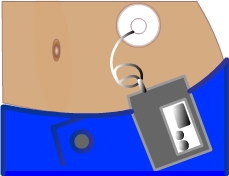 Insulin pumps, also known as
continuous subcutaneous insulin infusion (CSII) devices, are programmed to deliver
a continuous infusion of insulin subcutaneously. A CSII system consists of a pump
and an infusion set small enough to be carried in a pocket, worn on a belt, or
hidden under clothing.
Insulin pumps, also known as
continuous subcutaneous insulin infusion (CSII) devices, are programmed to deliver
a continuous infusion of insulin subcutaneously. A CSII system consists of a pump
and an infusion set small enough to be carried in a pocket, worn on a belt, or
hidden under clothing.
Insulin pump therapy more closely approximates the normal physiological fluctuations in plasma insulin than multiple subcutaneous insulin injections. It achieves this by:
The glucose lowering effects
of a CSII system are highly predictable because insulin is delivered at a precise
rate and programmed according to the patient’s needs. The patient can be
taught to adjust the basal rate and bolus doses for exercise, illness, and between
meal hyperglycemia.
Insulin pump therapy requires frequent self-monitoring of blood glucose levels – at least 4 times a day – and meticulous care of the equipment. The currently available CSII device does not automatically make adjustments in insulin dosage based on the individual’s blood glucose level. Thus, the patient must monitor his or her blood glucose before each meal, determine the amount of insulin needed, and program the pump to deliver the amount of insulin required.
Advantages of pump therapy
include a greater flexibility in meal timing and content and greatly improved
control of blood glucose levels. Disadvantages include the danger of rapid development
of diabetic ketoacidosis if the flow of insulin is interrupted, skin infections
at the infusion site, and a decrease in hypoglycemic awareness. Skin infections
can be prevented or minimized with meticulous skin care, and hypoglycemic episodes
can be minimized by frequently monitoring blood glucose levels.
Instant Feedback: